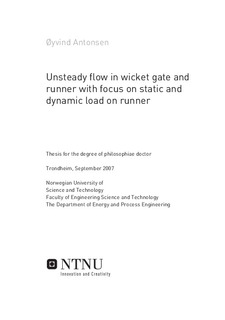| dc.contributor.author | Antonsen, Øyvind | nb_NO |
| dc.date.accessioned | 2014-12-19T11:43:36Z | |
| dc.date.available | 2014-12-19T11:43:36Z | |
| dc.date.created | 2008-02-19 | nb_NO |
| dc.date.issued | 2007 | nb_NO |
| dc.identifier | 123597 | nb_NO |
| dc.identifier.isbn | 978-82-471-3408-5 | nb_NO |
| dc.identifier.uri | http://hdl.handle.net/11250/233347 | |
| dc.description.abstract | This thesis presents a study on unsteady flow at the inlet of the runner in a Francis turbine. The main goal has been to find a connection between the design of the wicket gate and the dynamic load on the runner due to rotor stator interaction. The working hypothesis has been based on the theory that correct profiling of the wicket gate can make the pressure distribution at the inlet of the runner more uniform, and hence, reduce the dynamic load on the runner.
Velocity measurements by means of Laser Doppler Anemometry (LDA) have been carried out in a cascade rig with different wicket gate profiling. Also, the pressure around the surface of one wicket gate has been measured. CFD calculations, validated with the LDA-measurements, have been used to calculate the pressure distribution at the inlet of the runner with different profiling of the wicket gate and the corresponding load on the runner.
The LDA measurements have shown that the wake in a turbine cascade follows the classic wake theory fairly well. The wakes tends to mix out faster than according to the wake theory, due to the accelerated flow field. The CFD results deviate somewhat from the LDA measurements, but have shown good agreement with relative changes in the geometry. The 2D CFD calculations under-estimates the depth of the wake with ca 25 % while with 3D calculations the deviation is about 10 %, which has been considered to be good agreement.
Due to this consideration, it has been found trustworthy to use CFD to compare pressure distribution with different profiling of the wicket gate. The results show that by profiling the guide vanes asymmetric with the ’flat’ side pointing toward the runner, the pressure distribution becomes more uniform. This is also shown by the pressure measurements around the guide vane profile.
A simplified CFD-calculation of guide vane/runner interaction has shown that a more uniform pressure distribution at the inlet of the runner will reduce the dynamic load variation on the runner blade without increasing the losses in the flow. | nb_NO |
| dc.language | eng | nb_NO |
| dc.publisher | Fakultet for ingeniørvitenskap og teknologi | nb_NO |
| dc.relation.ispartofseries | Doktoravhandlinger ved NTNU, 1503-8181; 2007:155 | nb_NO |
| dc.relation.haspart | Antonsen, Øyvind; Nielsen, Torbjørn K. CFD simulation of von Karman vortex shedding. . | nb_NO |
| dc.relation.haspart | Antonsen, Øyvind; Nielsen, Torbjørn K; Dahlhaug, Ole G. Experimental and theoretical investigations of the flow field at the inlet of a Francis runner. . | nb_NO |
| dc.relation.haspart | Antonsen, Øyvind; Nielsen, Torbjørn K; Dahlhaug, Ole G; Billdal, Jan T.. Pressure Pulses in Francis Turbines vs. Guide Vane Design. . | nb_NO |
| dc.title | Unsteady flow in wicket gate and runner with focus on static and dynamic load on runner | nb_NO |
| dc.type | Doctoral thesis | nb_NO |
| dc.contributor.department | Norges teknisk-naturvitenskapelige universitet, Fakultet for ingeniørvitenskap og teknologi, Institutt for energi- og prosessteknikk | nb_NO |
| dc.description.degree | PhD i energi- og prosessteknikk | nb_NO |
| dc.description.degree | PhD in Energy and Process Engineering | en_GB |
